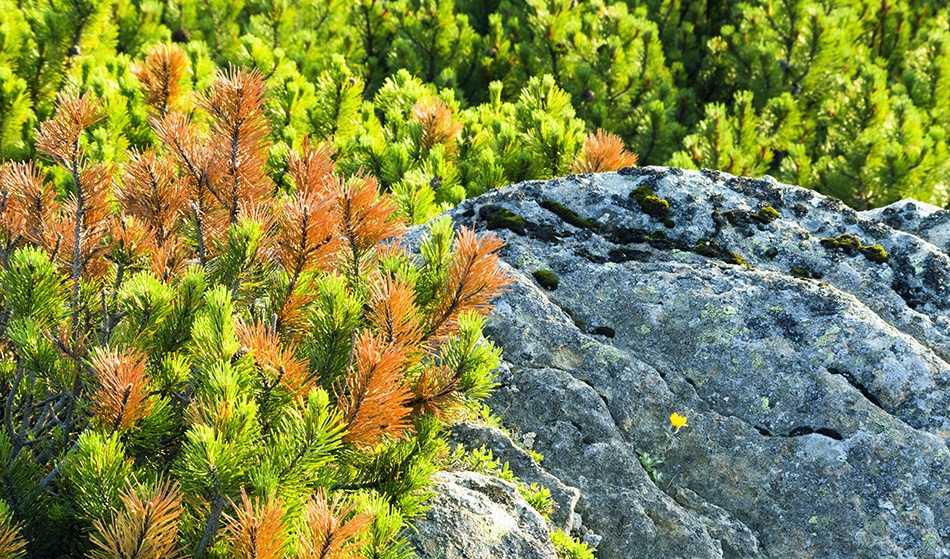Scientists at the University of California, Berkeley have discovered that when pine trees are exposed to ultraviolet radiation, they become temporarily sterile. This supports the theory that ozone depletion contributed to the mass extinction on Earth 252 million years ago.
There has been a global ban on chlorofluorocarbon refrigerants since the 1980s after holes in the ozone layer started to develop. Certain industrial chemicals have also been shown to be destroying the atmospheric ozone, which acts as the planet’s sunscreen to protect us from dangerous UV-B rays. There are many different types of ultraviolet radiation, but it is the UV-B rays which have been shown to cause genetic mutations.
 Image credit: Denys Dolnikov/Shutterstock
Image credit: Denys Dolnikov/Shutterstock
University of California graduate Jeffrey Benca exposed dwarf pines to 13 times the levels of UV-B radiation normal for a sunny day and observed the effect of high UV on conifers and other trees. During the two-month experiment, none of the trees died but all seed cones, or pine cones, shriveled up only days after emerging, leaving the trees sterile. When placed outside, the trees regained the ability to produce healthy seed cones in later years. The results were published recently in Science Advances.
The extinction at the end of the Permian is thought to have been caused by volcanic eruptions in Siberia that produced the Siberian Traps, which are lava fields covering northern Russia. It is thought that the volcanic gases that contain halocarbons were what destroyed Earth’s ozone layer, causing the increase in UV-B exposure affecting life and causing genetic mutations in pollen and spores of plants worldwide.
When ancient trees regained their fertility, the repeated bouts of sterility would have caused a decrease in population growth over time, which leads to a collapsing biosphere. When dominant plant lineages are disturbed globally repeatedly, the food web base also becomes unstable, which affects animals as well as plants.
With pulses of volcanic eruptions happening, we would expect pulsed ozone shield weakening, which may have led to forest declines previously observed in the fossil record.
Jeffrey Benca, University of California Graduate
Benca used plant growth chambers as a time machine to test the potential of a hypothesis about what may have happened 252 million years ago. The experiments showed how extinction on land might have been caused by reproductive troubles at the base of the food chain. The first experiment used pines, and it was designed to find out whether high levels of UV-B could cause malformed pollen grains in today’s seed plants and whether these malformations could affect reproduction.
In 2013 60 dwarf clonal pines were taken to Berkeley, after acclimating them for a year outdoors in full sun with sparse water and nutrient-poor soil. In three separate indoor UV chambers, Benca exposed the dwarf pines to 7.5, 10 and 13 times Berkeley’s normal UV-B intensity, which went along with predictions of what would’ve happened after the impact of the Siberian Trap eruptions
The results produced pollen that was malformed. With medium and extreme exposures, up to 15 percent of pollen grains were found to be misshaped, but only 3 percent of grains were affected in the normal to low-exposure levels. Benca spent three years carrying out his research and compared more than 57,000 pollen grains that were produced by trees in the chambers. Previous studies have predicted that pollen yields with more than 3 percent of malformed grains, which were present in Benca’s experiments, would have caused environmental stress in modern conifers.
Jeff’s UV-B-blast experiment produced pollen abnormalities in a modern conifer similar to abnormalities observed in 252-million-year old microfossils was one of the most exciting things I’ve seen this decade.
Ivo Duijnstee, Co-Author
A surprise to the researchers was that not only trees exposed to high levels of UV, but all trees that were subjected to increased UV levels became sterile. Their seed cones shriveled up before fertilization could take place. It is thought the cause of this was as an automatic reaction to UV-B stress, as even seed cones that were hidden in amongst the foliage died.
Today’s pines are different to those all those years ago, being more heavily reinforced with their interlocking cone scales to shield their seeds, but even the new tree species discarded their seed cones, despite being previously thought to quite resilient to increased UV levels
Disclaimer: The views expressed here are those of the author expressed in their private capacity and do not necessarily represent the views of AZoM.com Limited T/A AZoNetwork the owner and operator of this website. This disclaimer forms part of the Terms and conditions of use of this website.